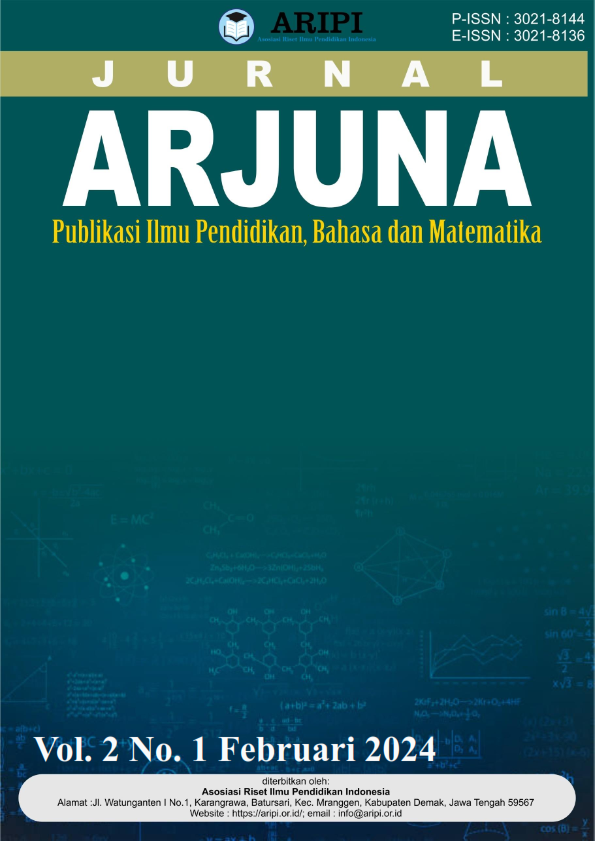Miskonsepsi Pemahaman Materi Bangun Datar dengan Penerapan Teori Polya di PGMI 3 UIN Sumatera Utara
DOI:
https://doi.org/10.61132/arjuna.v2i1.521Keywords:
Misconceptions, Flat Figures, Polya TheoryAbstract
Misconceptions are misunderstandings in understanding mathematical concepts. Mathematics misconceptions are still experienced by many students in tertiary institutions. The aim of this research was to analyze errors in understanding questions about Flat Figures by applying Polya Theory. Polya's theory consists of 4 steps, namely understanding the problem, planning, implementing and assessing. This type of assessment is descriptive qualitative research. This research was conducted on PGMI 3 students by taking 6 students as research subjects. The supporting instruments in this research are a 2-item ability test about Flat Figures, observation and interviews. The results of this research indicate that there are misconceptions that occur in understanding Flat Figure problems by applying Polya Theory, namely that out of 6 students there are 4 people who experience misconceptions. Factors that cause students to experience misconceptions include internal and external factors. Internal factors include students not writing down notations/symbols, and students' lack of understanding of the steps of polya theory. Meanwhile, the external factor is that students have too many outside activities so they don't focus on working on plane shape questions given by the teacher and there is a lack of motivation for students to work on plane shape questions.
Downloads
References
Babys, U. (2020). Analisis Kemampuan Komunikasi Matematika Siswa Ditinjau dari Gender. ANARGYA: Jurnal Ilmiah Pendidikan Matematika, 3, 26.
Depdiknas. (2006). Permendiknas No 22 tahun 2006 tentang standar isi. (Jakarta: Depdiknas).
Hidayah, S. Dkk. (2019). Analisis Kesalahan-kesalahan Mahasiswa Dalam Menyelesaikan Soal Induksi Matematika. Jurnal Review Pendidikan Dan Pengajaranv(JRPP, 5.
Irawan, E. (2021). Deteksi Miskonsepsi di Era Pandemi. (Yogyakarta: Zahir Publishing).
Jannah, N. R., & Hidayanto, E. (2021). Analisis Miskonsepsi Siswa Sma Dalam Menyelesaikan Soal Matematika Materi Barisan Dan Deret Berdasarkan Cri Dan Scaffoldingnya. Seminar Nasional Matematika Dan Pembelajarannya, 82–94.
Novitasari, D. (2016). Pengaruh Penggunaan Multimedia Interaktif Terhadap Kemampuan Pemahaman Konsep Matematis Siswa. FIBONACCI: Jurnal Pendidikan Matematika Dan Matematika, 2(2), 8.
Pinahayu, E. A. R. Dkk. (2023). Analisis Miskonsepsi Mahasiswa dalam Mneyelesaikan Soal Sistem Persamaan Linear (SPL) Berdasarkan Tahapan Newman. Journal Of Education, 5, 4381–4390.
Sugiyono. (2016). Metode Penelitian Kuantitatif Kualitatif dan R&D (p. 62).
Unaenah, E. Dkk. (2020). Teori Brunner Pada Konsep Datar Sekolah Dasar. Nusantara : Jurnal Pendidikan Dan Ilmu Sosial, 2, 328–239.
Utomo, D. P. (2011). Masalah-Masalah Dalam Pembelajaran Matematika Di Sltp. Widya Warta, 01(01), 196–204.
Yani, M. Dkk. (2016). Proses Berpikir Siswa Sekolah Menengah Pertama Dalam Memecahkan Masalah Matematika Berdasarkan Langkah-langkah Polya Ditinjau Dari Adversity Quotinet. Jurna Pendidikan Matematika, 10.
Zakiah, N. E. Dkk. (2019). Implementasi Pendekatan Kontekstual Pada Model Pembelajaran Berbasis Masalah Berdasarkan Langkah-langkah Polya. Teorema : Teori Dan Riset Matematika, 4, 4.
Downloads
Published
How to Cite
Issue
Section
License
Copyright (c) 2023 Jurnal Arjuna : Publikasi Ilmu Pendidikan, Bahasa dan Matematika

This work is licensed under a Creative Commons Attribution-ShareAlike 4.0 International License.






